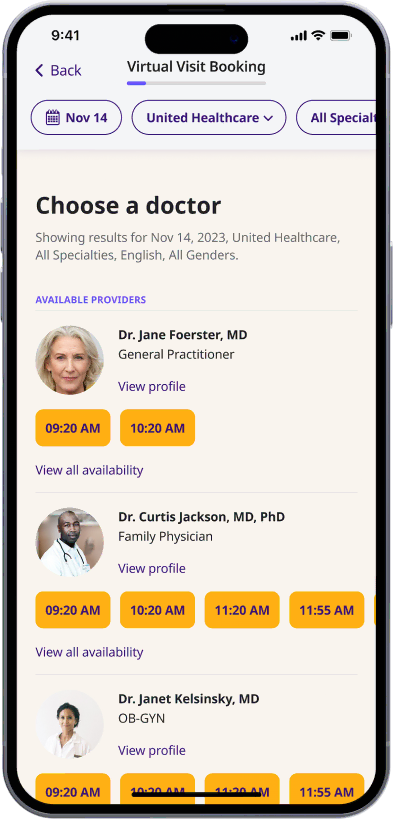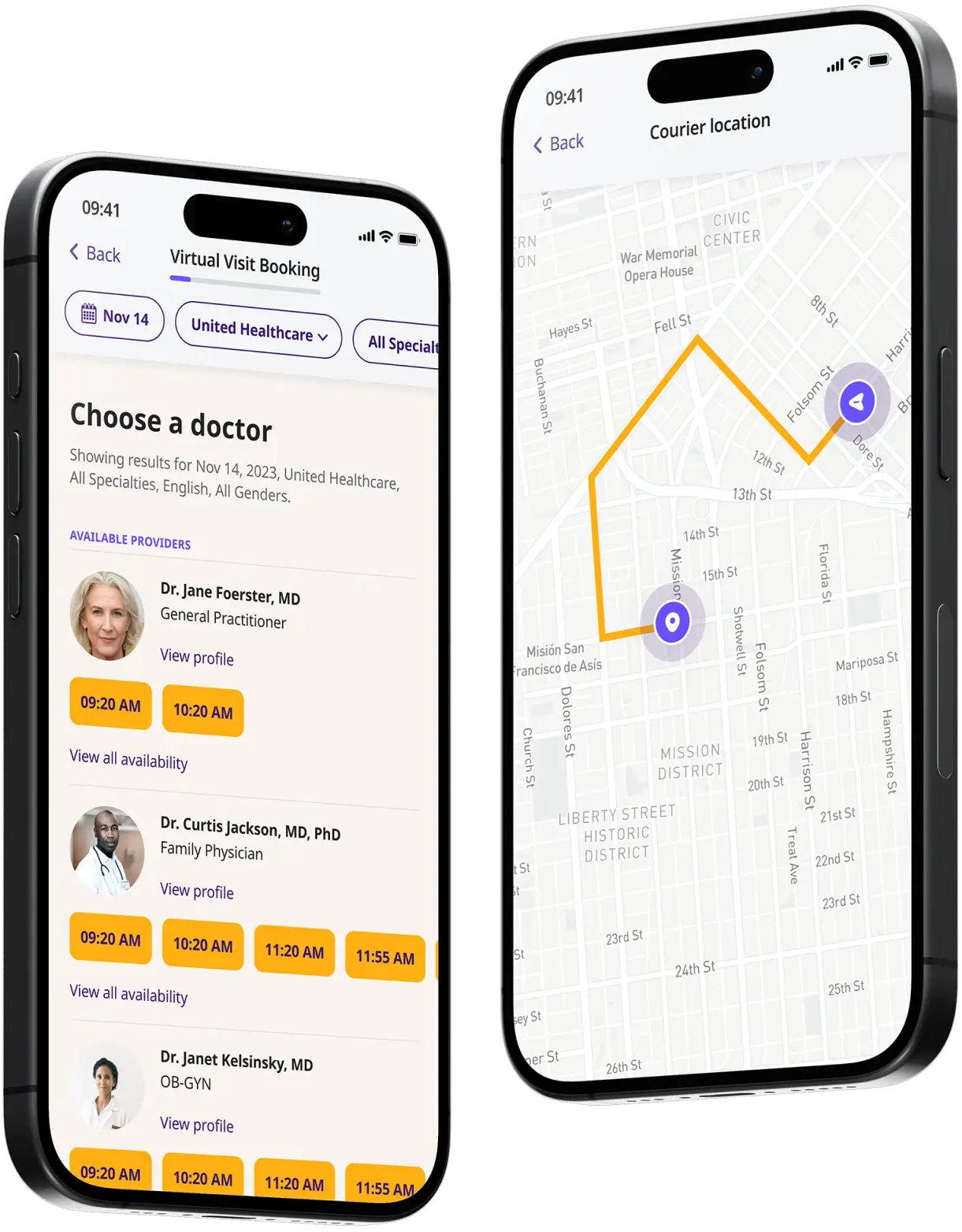Get a Nitrofurantoin Prescription Online (Macrobid)
Get a prescription for nitrofurantoin (Macrobid) now! Our doctors are available 24/7 in all 50 states.


Available in 50 states. Insurance accepted.
Fast
virtual visits
24/7 care
assistants
Prescriptions
as needed



See If Delivery Is Available Near You
Delivery Not Available
Enter your ZIP code to check if prescription delivery is available in your area and how soon your meds could arrive.
How to get started
Choose your doctor, start a virtual visit, and have your prescriptions sent to your preferred pharmacy for pickup — all in just a few easy steps.
Choose a doctor
Choose a physician by availability, specialty, ratings, and more.

Start a video call
Get connected with a doctor anytime, anywhere.

1-Hour Rx Delivery
Your prescription delivered to your door in 1 hour or less.

Available in 50 states. Insurance accepted.
One-Time
Physician Visit
One-time visit with a physician for diagnosis, treatment, Rx, labs, referrals, and doctor’s notes.
Accepted Insurances
See why people turn to DrHouse...
As seen in

Nitrofurantoin (Generic Macrobid)
What Is Nitrofurantoin?
Nitrofurantoin is an antibiotic used to treat and prevent urinary tract infections (UTIs). It is classified as a nitrofuran antibiotic and is primarily sold under the brand name Macrobid.
It is also sold and marketed under other brand names such as Macrodantin, Furadantin, and Furamag.
Nitrofurantoin works by stopping bacteria from growing in the urinary tract and the bladder, which helps to combat infection.
This medication is available in tablets, capsules, and liquid suspension.
What Is Nitrofurantoin Used For?
Nitrofurantoin is used to treat many urinary tract infections such as cystitis, pyelonephritis, and acute uncomplicated UTIs. It is effective against many of the bacteria that can cause UTIs, such as Escherichia coli (E. coli).
Nitrofurantoin specifically targets bacteria in the urinary tract, so its action is concentrated there which makes it effective against UTIs but not as useful for infections elsewhere in the body.
It is also commonly prescribed for preventing recurrent UTIs in women who have had more than two episodes in the past year.
How Does Nitrofurantoin Work?
Nitrofurantoin has a unique mechanism of action that distinguishes it from many other antibiotics.
After oral consumption, nitrofurantoin gets filtered out of your blood and is excreted into the urine, achieving high concentrations directly within the urinary tract. This ensures its primary action is localized to the urinary system, making it especially potent against UTIs.
Nitrofurantoin works by creating reactive substances inside bacterial cells. These substances harm the bacteria’s DNA, preventing them from growing and multiplying effectively.
What Are the Side Effects of Nitrofurantoin?
The most common side effects of taking nitrofurantoin are:
- Nausea
- Vomiting
- Diarrhea
- Loss of appetite
- Headaches
- Fatigue
- Dizziness
- Dark yellow or brown urine
More serious and rare side effects may include:
- Lung issues: Difficulty breathing, chills, fever, chest pain.
- Liver problems: Yellowing of the skin or eyes (jaundice), severe nausea, severe stomach pain.
- Nerve disorders: Numbness, tingling, or pain in the hands or feet.
- Hemolytic anemia: Fatigue, paleness, and rapid heartbeat.
- Severe skin reactions: Rashes, itching, or more severe skin conditions.
- Blood cell changes: Easy bruising, increased infections, excessive bleeding.
- Vision changes: Due to inflammation of the optic nerve.
- Pancreatitis: Severe abdominal pain.
The listed side effects are not all the possible side effects of taking nitrofurantoin. If you experience any serious symptoms while taking nitrofurantoin, contact your doctor or healthcare provider immediately.
If you experience any lung issues such as difficulty breathing, seek medical attention immediately.
How to Take Nitrofurantoin?
Just like with any prescription medication, it is important to follow all of your doctor’s instructions when taking nitrofurantoin.
- It’s recommended to take nitrofurantoin with food to reduce the risk of stomach upset and to enhance the absorption of the drug
- It is important to finish your entire course of medication. Even if you feel better, you should continue taking the medication until it is finished. If you stop too soon, the infection may return and be harder to treat.
- If you’re taking nitrofurantoin in capsule form, swallow the capsule whole. Do not crush, break, or open the capsule.
- If you miss a dose of Nitrofurantoin, take it as soon as you remember. However, if it’s close to the time of your next dose, skip the missed dose and continue with your regular schedule. Do not double the dose to catch up.
- It should be stored at room temperature and away from moisture, heat, and light
Frequently Asked Questions About Nitrofurantoin
Is Nitrofurantoin Safe?
Nitrofurantoin is generally considered safe if it’s used as prescribed. However it may not be suitable for everyone and its safety depends on individual factors, appropriate use, and awareness of potential risks. You should speak with a healthcare provider about possible risks before starting a course of nitrofurantoin.
How Long Does It Take Nitrofurantoin to Clear a UTI?
When taking Nitrofurantoin it usually takes 2 to 3 days before UTI symptoms start to improve. It will take 5 to 7 days for the infection to clear.
The exact duration can vary based on the specific case, the severity of the infection, and individual factors. Some infections might require a longer duration of treatment, especially if they are more complicated or if the initial treatment is not effective.
Also is important to finish taking your course of medication even if you start feeling better after a few days, as the infection may return and be harder to treat.
Which Is Better for a UTI Amoxicillin or Nitrofurantoin?
Both Amoxicillin and Nitrofurantoin are antibiotics used to treat urinary tract infections (UTIs). Which one is better for a UTI depends on several different factors such as the severity of your infection, any underlying medical conditions, and individual factors.
For uncomplicated UTIs, Nitrofurantoin (Macrobid) is the more frequent first choice. It is generally well tolerated, and it is effective against many bacteria that cause UTIs.
Is Macrobid a Strong Antibiotic for a UTI?
Yes, Macrobid is an effective antibiotic for treating urinary tract infections (UTIs). It works by specifically targeting bacteria in the urinary tract, which makes it especially effective against UTIs.
What to Avoid While Taking Nitrofurantoin?
Like with most medications, there are a few things you should avoid while taking Nitrofurantoin. Such as:
- Avoid taking any other medications without consulting a doctor first.
- Avoid drinking alcohol, as it may amplify some of the drug’s side effects
- Avoid antacid or indigestion remedies containing magnesium trisilicate
To learn more about Nitrofurantoin and what to avoid while taking it, talk to your doctor or healthcare provider.
How Long Is Nitrofurantoin Prescribed for?
Nitrofurantoin is usually prescribed for 5 to 7 days when treating UTIs. The overall duration for which nitrofurantoin is prescribed will depend on the severity and type of infection being treated. You must finish your entire course of nitrofurantoin as prescribed by your doctor, even if you start to feel better.
Can You Get Nitrofurantoin Over-the-Counter?
No, Nitrofurantoin is a prescription medication and it is not available over-the-counter. To get Nitrofurantoin, you must get a prescription from a licensed doctor.
Can You Get a Nitrofurantoin Prescription Online From DrHouse?
Yes, you can get a prescription for Nitrofurantoin online from DrHouse. Our licensed physicians are able to evaluate your symptoms and medical history through our secure telemedicine platform and determine if a prescription for Nitrofurantoin is the right treatment option for you.
For more detailed information about nitrofurantoin, you can refer to the following sources:
- Macrobid prescription label, Food and Drug Administration (FDA).
- Nitrofurantoin, Drugs.com.
- Nitrofurantoin, MedlinePlus
The content on this page has been medically reviewed for accuracy and comprehensiveness by Amy Dougherty, FNP-BC, AGAC
Related services
Explore more of our services tailored to your needs and discover additional ways we can support your healthcare needs.
Frequently asked questions



